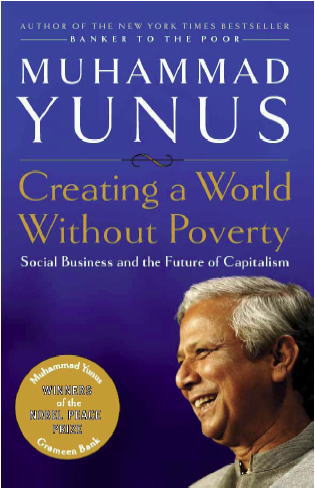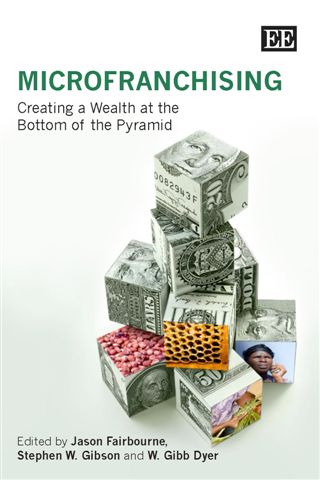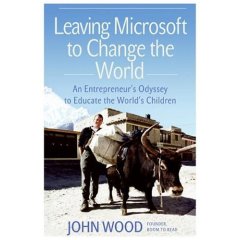A lively debate has been sparked by Mike Edward’s new book “Just Another Emperor-The Myths and Realities of Philanthrocapitalism” where he challenges the increasing use of business thinking in philanthropy and the current hype about it. It is in fact a controversial topic but certainly a healthy debate. I got to know about this topic as I follow Nextbillion where now the whole team is writing their comments on this subject.(highly recommended read). Also there is an on-line debate on this subject hosted by Global Philanthropy Forum. Here you can read comments from Matthew Bishop from the Economist who coined the word “philanthrocapitalism” and has written a book with Michael Green titled “Philanthrocapitalism: how the rich can save the world” coming out this fall.
I believe strongly that today there is a powerful movement of making the world a better place (the subject of my latest book) which has been accelerating due to the converging business (for-profit) and social (non-profit) worlds. Both worlds offer principles and methods in different areas that they ought to learn from each other. It is important to sort out what can be used most effectively from each world. I think that this is a timely debate and look forward to see the outcomes.
Category Archives: Books
New book: Kleiner Einsatz Grosse Wirkung (Beyond Microfinance: The Movement of Making the World a Better Place) by Naoko Felder

Starting with an update on microfinance, it covers other innovative market-oriented models such as base of the pyramid (BOP) businesses, social enterprises and microfranchises. These models together with microfinance are improving the lives of the 4 billion people living at the BOP. The last section covers in detail a remarkable example in this area, Scojo Foundation. Scojo is developing the market for affordable reading glasses at the BOP through microfranchising.The book provides the author’s insights on 1) how the business (for-profit) and social (non-profit) worlds have been converging, setting the stage for these new models to emerge, 2) how these models, the people behind them, and the advent of Web 2.0, are creating a strong and positive movement towards a more responsible, sustainable and kinder world and 3) how all of us could make a difference.The book has been published in German language by rueffer and rub with the title >Kleiner Einsatz Grosse Wirkung. (Small input, big impact – thus,the red chilis of the cover) This book illustrates a giga trend, the powerful movement of making the world a better place.
Book:Creating a World Without Poverty: Social Business and the Future of Capitalism by Yunus Muhammad
 Muhammad Yunus, Nobel Peace Price winner, in his continuing fight to make poverty history promotes a new type of enterprise which has as its objective to make a difference. These social business enterprises will be self sustainable, in his words “no loss, no dividend enterprises”. He refers to two types of such enterprises one having investors like the latest joint venture between Grameen and Danone, an enterprise providing fortified yoghurt to malnourished children. Investors will get their capital back, but, profits will be injected back to the company to continue to achieve its objective. The second type of social business enterprise is a for-profit model but owned by the poor such as Grameen Bank.This book goes in depth explaining his “Next Big Idea” social businesses and also present some ideas on how corporations and individuals can take part in achieving a “world without poverty”. It is inspirational and of course uplifting. Highly recommended. Past related entry on this topic, “Muhammad Yunus promotes social businesses”http://www.microfinance.ws/microfinance/2006/12/
Muhammad Yunus, Nobel Peace Price winner, in his continuing fight to make poverty history promotes a new type of enterprise which has as its objective to make a difference. These social business enterprises will be self sustainable, in his words “no loss, no dividend enterprises”. He refers to two types of such enterprises one having investors like the latest joint venture between Grameen and Danone, an enterprise providing fortified yoghurt to malnourished children. Investors will get their capital back, but, profits will be injected back to the company to continue to achieve its objective. The second type of social business enterprise is a for-profit model but owned by the poor such as Grameen Bank.This book goes in depth explaining his “Next Big Idea” social businesses and also present some ideas on how corporations and individuals can take part in achieving a “world without poverty”. It is inspirational and of course uplifting. Highly recommended. Past related entry on this topic, “Muhammad Yunus promotes social businesses”http://www.microfinance.ws/microfinance/2006/12/
The book “MicroFranchising”
 MICROFRANCHISING: Creating Wealth at the Bottom of the Pyramid, the first major publication on this subject, is now available. (Edward Elgar Publishing). This edited volume comprising 13 chapters and 18 authors introduces the concept of microfranchising and discusses how this business model can be effectively used for poverty alleviation. Different models of microfranchising are reviewed and specific case studies are highlighted to show how it has worked and is working in different parts of the world. Also the advantages as well as potential problems and pitfalls of microfranchising are discussed. My contribution was on the subject of “Microfranchise Funding” (Chapter 12).
MICROFRANCHISING: Creating Wealth at the Bottom of the Pyramid, the first major publication on this subject, is now available. (Edward Elgar Publishing). This edited volume comprising 13 chapters and 18 authors introduces the concept of microfranchising and discusses how this business model can be effectively used for poverty alleviation. Different models of microfranchising are reviewed and specific case studies are highlighted to show how it has worked and is working in different parts of the world. Also the advantages as well as potential problems and pitfalls of microfranchising are discussed. My contribution was on the subject of “Microfranchise Funding” (Chapter 12).
If there is one thing I could hope for is that the price for this book would be a bit lower so more people can afford to buy it and read it.
“The Next 4 Billion” BOP market report by WRI
The Next 4 Billion: Market Size and Business Strategy at the Base of the Pyramid is a timely and valuable contribution by the team of WRI (Allen L. Hammond, William J. Kramer, Robert S. Katz, Julia T. Tran, Courtland Walker). This reports gives a detailed economic portrait of the BOP based on recorded incomes and expenditures and an overview of sector-specific business strategies from successful enterprises operating in the BOP markets. It is full of data and information that is needed for the private sector which is currently increasing its engagement to this large segment.
Inspiring story-Leaving Microsoft to Change the World

This book is the story of John Wood an ex-executive of Microsoft who founded “Room to Read”, an NPO that promotes literacy throughout the developing world. Since its inception in 2000, Room to Read has established over 3000 libraries, constructed 221 schools, published 99 local language children’s titles, donated 1.2mn English books, funded 2344 long-terms girl scholarships, and established 108 computer and language labs in developing countries (Nepal, Cambodia, Vietnam, India, Laos, Sri Lanka, South Africa). What impressed me was not only the results but how they operate. In other words it is a model of the new breed of npos that are managed with professional business practices i.e., a management calling for scalable, sustainable and measurable results. The communities involved co-invest with Room to Read through the Challenge Grant Model for constructing the schools/libraries thus facilitating the long term sustainability of the projects. Also this book provides very good information on how to raise funds if one is building up an npo.
Book Tip: The End of Poverty by Jeffrey Sachs
This is not a new book (came out in early 2005) but it is a must read and one of the most educational books I read in 2006. Jeffrey Sachs provides a clear strategy on how to end extreme poverty by 2025. What I found most informative were the explanations on why poverty had not diminished but increased in some areas in Africa after decades of the so-called aid or perceived aid provided by the industrialized nations. Also it is a great update on the most influencing economic and business forces today as it covers extensively the news giants such as China, India and Russia.
Realizing Property Rights

“Realizing Property Rights” (Swiss Human Rights Book Volume 1) a book edited by Hernando de Soto and Francis Cheneval is now out (Publisher: Rüffer & Rub). This book deals with property rights as human rights seen from different cultural and historical contexts and from different thematic angles. It has been an honour for me to have been able to contribute a chapter for this book titled “Microcredit, MicroFranchising and Women Entrepreneurs”
